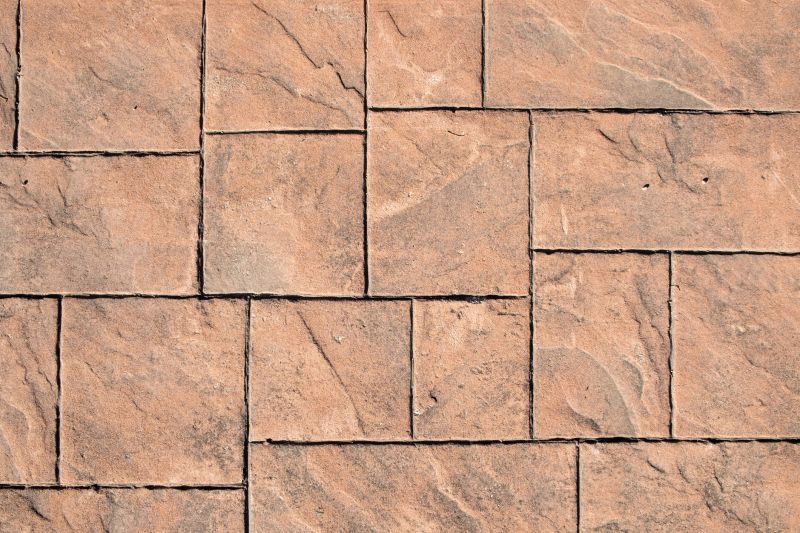Top-Rated Tools For Stamped Concrete Service Contractors
Equip yourself with the best tools and materials that streamline your stamped concrete projects and improve outcomes.
 Stamped concrete services in Louisville, KY, offer a versatile and aesthetically appealing option for enhancing outdoor spaces such as patios, walkways, driveways, and pool decks. This decorative technique involves imprinting patterns and textures onto freshly poured concrete, creating the appearance of stone, brick, slate, or other materials. The process begins with a skilled application of color stains and integral dyes, which can be combined with stamping mats to produce a wide array of visual effects. Properly selected products and tools are essential for achieving durable, visually appealing results that can withstand Louisville's varied climate conditions.
Stamped concrete services in Louisville, KY, offer a versatile and aesthetically appealing option for enhancing outdoor spaces such as patios, walkways, driveways, and pool decks. This decorative technique involves imprinting patterns and textures onto freshly poured concrete, creating the appearance of stone, brick, slate, or other materials. The process begins with a skilled application of color stains and integral dyes, which can be combined with stamping mats to produce a wide array of visual effects. Properly selected products and tools are essential for achieving durable, visually appealing results that can withstand Louisville's varied climate conditions.
Top Overall Option
Comprehensive Stamped Concrete Kit
A complete stamped concrete kit that includes a variety of stamping mats, colorants, release agents, and sealers designed to work together for a seamless decorative concrete application. This all-in-one set simplifies the process for both professionals and DIY enthusiasts, providing versatile options to achieve durable and visually appealing stamped surfaces. The kit's components are selected for compatibility, ensuring consistent results and a professional finish that can enhance outdoor spaces in Louisville, KY.
Types of Products For Stamped Concrete Service
Stamping Mats
Flexible rubber or polyurethane mats used to imprint patterns onto freshly poured concrete, available in various designs to mimic natural stone, brick, or custom textures.
Color Hardeners
Powdered coloring agents applied to concrete surface to add vibrancy and depth, often used in combination with stains for enhanced visual effects.
Integral Dyes
Liquid colorants mixed into concrete before pouring to provide a uniform base color that complements stamped patterns.
Release Agents
Materials applied to stamping mats to prevent sticking and to create a contrasting color effect on the surface.
Concrete Sealers
Protective coatings that seal the finished stamped surface against moisture, UV rays, and wear, available in matte, satin, or glossy finishes.
Color Stains
Liquid or powdered stains used to add color accents and enhance the texture of stamped concrete surfaces.
Texture Rollers
Tools used to add additional surface textures or patterns to stamped concrete for a more natural look.
Curing Compounds
Products that retain moisture in the concrete during curing, ensuring strength and durability for stamped surfaces.
Edge Restraints
Materials used to define borders and prevent cracking or shifting in stamped concrete areas.
Concrete Admixtures
Additives that improve workability, setting time, and durability of stamped concrete mixes.
Popular Choices
Pre-designed pattern kits that include multiple mats for creating consistent and attractive stamped textures.
All-in-one colorant packages combining dyes and stains for easy application and color matching.
Equipment designed for efficient application of sealers, ensuring even coverage and protection.
Small stones or chips added to sealers or overlays to enhance visual interest and texture.
Complete sets of hand tools and rollers for detailed stamping and texturing work.
Tools used to add subtle surface variations and textures for a natural appearance.
Thin overlays that can be stamped and colored to refresh existing concrete surfaces.
Durable coatings that can be applied over stamped concrete for added protection and aesthetic appeal.
Materials used to fill expansion joints and prevent cracking in stamped concrete areas.
Specialized cleaners to prepare stamped concrete surfaces before sealing or coloring.
In addition to the stamping mats themselves, a variety of ancillary products are used to prepare, seal, and finish stamped concrete surfaces. These include release agents that prevent the mats from sticking, color hardeners that add depth and vibrancy, and sealers that protect the finished surface from wear and weathering. When selecting products for stamped concrete, it is important to consider compatibility with existing concrete and the specific aesthetic goals of the project. High-quality products can help ensure a long-lasting, professional-looking finish that enhances the property's curb appeal.
Louisville homeowners and contractors often seek products that facilitate ease of application, quick drying times, and effective protection against moisture and UV damage. Proper surface preparation, including cleaning and curing, is crucial for optimal results. By choosing the right combination of stamps, colorants, and sealers, users can create customized patterns that add character and value to outdoor spaces. Regular maintenance and re-sealing are recommended to preserve the appearance and integrity of stamped concrete over time, especially in regions with seasonal temperature fluctuations like Kentucky.
Key Buying Considerations
- Compatibility of products with existing concrete or overlays.
- Type of pattern or texture desired and availability of mats or tools.
- Color options and whether they can be combined for custom effects.
- Durability and weather resistance of sealers and coatings.
- Ease of application and whether professional assistance is recommended.
- Drying and curing times to plan project timelines effectively.
- Compatibility of release agents with stamping mats and other products.
- Environmental conditions such as humidity and temperature during application.
- Long-term maintenance requirements for preserving appearance.
- Budget considerations, including the cost of comprehensive kits versus individual products.
- Availability of color matching options for existing outdoor elements.
- Surface preparation needs to ensure optimal adhesion and finish.
- Safety precautions, including handling and ventilation during application.
- Application techniques suitable for DIY projects versus professional installations.
- Product shelf life and storage conditions to maintain effectiveness.
